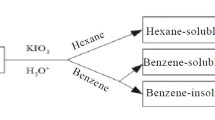The relationships of the reaction of the of tar asphaltenes with concentrated nitric acid were studied under various quantitative, temperature, and time conditions. According to IR spectroscopic data, nitration occurs to the highest degree during the action of a 50-fold excess of 64% nitric acid on the asphaltenes at 60°C for 4 hours. Nitration is accompanied by oxidation side reactions leading to the formation of nitrate, phenolic, carbonyl, and sulfoxide groups. It was established by mass spectrometry that there is a tendency for the number-average and weight-average molecular weights of the nitration products to decrease in comparison with the initial asphaltenes. It was found by electron paramagnetic resonance that the content of stable free radicals and vanadyl complexes in the products of the nitration reaction decreases.




Similar content being viewed by others
Change history
15 November 2021
A Correction to this paper has been published: https://doi.org/10.1007/s10553-021-01318-8
References
N. A. Mironov, G. R. Abilova, K. O. Sinyashin, et al., Energy & Fuels, 32, No. 1, 161–168 (2018).
L. E. Foss, K. V. Shabalin, L. I. Musin, et al., Petrol. Chemistry, 60, 709–715 (2020).
K. Shofield, Aromatic Nitration, Cambridge Univer. Press, London, New York (1980), p. 376.
M. I. Konovalov, Comptes Rendus de I’Academie des Sciences, 114, 26 (1892).
H. Feuer, Nitro Compounds, Recent Advances in Synthesis and Chemistry, VCH, Weinheim (1990), p. 636.
D. J. Belson, A. N. Strachan, J. Chem. Soc. Perkin Trans., 2, 15–19 (1989).
H. Feuer, The Chemistry of the Nitro and Nitroso Groups [Russian translation], Mir, Moscow (1973), in 2 volumes.
Yu. V. Guk, M. A. Ilyushin, E. L. Golod, et al., Russ Chem Rev., 52, 284–297 (1983).
Japanese Pat. No. 51039601.
Chinese Pat. No. 111463017.
Y. V. Pokonova, Chemistry and Technology of Fuels and Oils, 48, No. 4, 308–312 (2012).
M. Plata-Gryl, M. Momotko, S. Makowiec, Separation and Purification Technology, 224, 315–321 (2019).
M. F. Al-Samarraie, W. Steedman, Liquid Fuels Technology, 3, 55–71 (1985).
O. A. Nagornova, L. E. Foss, K. V. Shabalin, et al., Petroleum Chemistry (2021) (at the press). https://doi.org/10.1134/S0965544121060013.
V. Ya. Ignatenko, Yu. V. Kostina, S. V. Antonov, et al., Zhurn. Prikl. Khimii, 1626–1632 (2018).
D. C. P. Lozano, J. A. Orrego-Ruiz, M. P. Barrow, et al., Fuel, 171, 247–252 (2016).
A. V. Topchiev, Nitration of Hydrocarbons and Other Organic Compounds [in Russian], Izd-vo Akad. Nauk SSSR (1956), Vol. 488.
L. J. Bellamy, Infrared Spectra of Complex Molecules [Russian translation] (Ed. M. Pentin), Moscow (1963).
Author information
Authors and Affiliations
Corresponding author
Additional information
Translated from Khimiya i Tekhnologiya Topliv i Masel, No. 4, pp. 65–71, July–August, 2021.
Rights and permissions
About this article
Cite this article
Nagornova, O.A., Foss, L.E., Shabalin, K.B. et al. Nitration of Petroleum Asphaltenes with Concentrated Nitric Acid under Various Conditions. Chem Technol Fuels Oils 57, 645–652 (2021). https://doi.org/10.1007/s10553-021-01289-w
Published:
Issue Date:
DOI: https://doi.org/10.1007/s10553-021-01289-w




